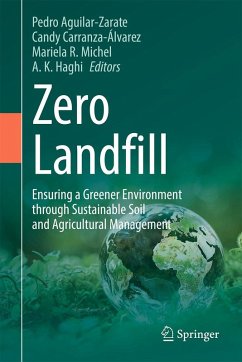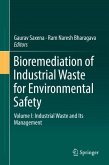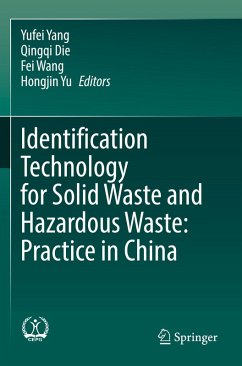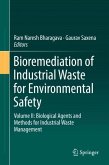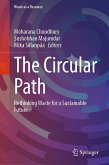Bioremediation Technology for Sustainable Mining Waste Management
Herausgegeben:Das, Alok Prasad
Bioremediation Technology for Sustainable Mining Waste Management
Herausgegeben:Das, Alok Prasad
- Gebundenes Buch
- Merkliste
- Auf die Merkliste
- Bewerten Bewerten
- Teilen
- Produkt teilen
- Produkterinnerung
- Produkterinnerung
Mining is essential to global economic development, but it also produces waste and pollutants such as heavy metals that can damage ecosystems and human health. Addressing these impacts requires practical, cost-effective, and sustainable solutions. This contributed volume presents a variety of cases that describe innovative, technology-based strategies for managing and reusing mining waste. Using case studies applicable to both developed and developing settings, research findings, and practical guidance, the book outlines methods that make mining waste management more efficient and environmentally responsible. …mehr
Andere Kunden interessierten sich auch für
![Advances in Organic Waste Conversion Through Industrial Biotechnology Advances in Organic Waste Conversion Through Industrial Biotechnology]() Advances in Organic Waste Conversion Through Industrial Biotechnology121,99 €
Advances in Organic Waste Conversion Through Industrial Biotechnology121,99 €![Zero Landfill Zero Landfill]() Zero Landfill121,99 €
Zero Landfill121,99 €![Bioremediation of Industrial Waste for Environmental Safety Bioremediation of Industrial Waste for Environmental Safety]() Bioremediation of Industrial Waste for Environmental Safety98,99 €
Bioremediation of Industrial Waste for Environmental Safety98,99 €![Identification Technology for Solid Waste and Hazardous Waste: Practice in China Identification Technology for Solid Waste and Hazardous Waste: Practice in China]() Identification Technology for Solid Waste and Hazardous Waste: Practice in China92,99 €
Identification Technology for Solid Waste and Hazardous Waste: Practice in China92,99 €![Bioremediation of Industrial Waste for Environmental Safety Bioremediation of Industrial Waste for Environmental Safety]() Bioremediation of Industrial Waste for Environmental Safety151,99 €
Bioremediation of Industrial Waste for Environmental Safety151,99 €![Innovative Technologies for Waste Management Innovative Technologies for Waste Management]() Innovative Technologies for Waste Management119,99 €
Innovative Technologies for Waste Management119,99 €![The Circular Path The Circular Path]() The Circular Path129,99 €
The Circular Path129,99 €-
-
-
Mining is essential to global economic development, but it also produces waste and pollutants such as heavy metals that can damage ecosystems and human health. Addressing these impacts requires practical, cost-effective, and sustainable solutions. This contributed volume presents a variety of cases that describe innovative, technology-based strategies for managing and reusing mining waste. Using case studies applicable to both developed and developing settings, research findings, and practical guidance, the book outlines methods that make mining waste management more efficient and environmentally responsible.
Produktdetails
- Produktdetails
- Sustainable Environmental Waste Management Strategies
- Verlag: Springer / Springer Nature Switzerland / Springer, Berlin
- Artikelnr. des Verlages: 89536657, 978-3-032-03467-0
- Seitenzahl: 498
- Erscheinungstermin: 22. Februar 2026
- Englisch
- Abmessung: 235mm x 155mm
- ISBN-13: 9783032034670
- ISBN-10: 3032034671
- Artikelnr.: 74933798
- Herstellerkennzeichnung
- Springer-Verlag GmbH
- Tiergartenstr. 17
- 69121 Heidelberg
- ProductSafety@springernature.com
- Sustainable Environmental Waste Management Strategies
- Verlag: Springer / Springer Nature Switzerland / Springer, Berlin
- Artikelnr. des Verlages: 89536657, 978-3-032-03467-0
- Seitenzahl: 498
- Erscheinungstermin: 22. Februar 2026
- Englisch
- Abmessung: 235mm x 155mm
- ISBN-13: 9783032034670
- ISBN-10: 3032034671
- Artikelnr.: 74933798
- Herstellerkennzeichnung
- Springer-Verlag GmbH
- Tiergartenstr. 17
- 69121 Heidelberg
- ProductSafety@springernature.com
Dr. Alok Prasad Das currently serves as an Assistant Professor in the Department of Life Sciences at Rama Devi Women’s University, Odisha, India. Prior to this, Dr. Das was an Assistant Professor in the Department of Chemical and Polymer Engineering at Tripura Central University, Agartala. Dr. Das has contributed significantly to research in Biological Wastewater Treatment, Bioremediation, Microplastic and Microfiber Pollution, and Geomicrobiology of extreme environments. His work has led to over 130 publications, including journal articles, books, and book chapters, and he has received several awards for his contributions to science and innovation. He has been supported by research grants from the Department of Science and Technology and the Department of Biotechnology, Government of India. As an editorial member of reputed journals, Dr. Das is also recognized for his leadership in guiding postgraduate and Ph.D. scholars. His work is internationally recognized, with an impressive Google Scholar citation count of 6500 and an h-index of 48. He has been listed in the Stanford University’s 2023 and 2024 list of the world’s top 2% most influential scientists.
Chapter 1: Water Contamination and Impacts on the Global Ecosystem: Effects on Rivers.- Chapter 2: Water Contamination and Its Impacts on the Global Ecosystem: Special Emphasis on Mining.- Chapter 3: Source of Mining Waste in the Environment, Their Fate and Toxicity.- Chapter 4: Impact of Mining Activities on the Terrestrial and Aquatic Environment.- Chapter 5: Health Hazards Related To Uranium Mining and Bioremediation As A Sustainable Approach.- Chapter 6: Advancements and Prospects in Microbial Remediation of Mining Wastewater.- Chapter 7: Advanced Physical and Biological Treatment Methods of Mining Pollutants.- Chapter 8: Novel and Eco-Friendly Techniques for the Remediation of Mining Pollutants.- Chapter 9: Bioremediation of Mining Waste Contaminated Water.- Chapter 10: Bioremediation of Mining Pollutants: Eco-Innovative Approaches Involved In Sustainable Development.- Chapter 11: Bioremediation As a Greener Alternative For Sustainable Recycling of Mining Waste.- Chapter 12: Microbial Leaching: An Environment-Friendly Approach To Metal Recovery.- Chapter 13: Turning Mining Waste to Wealth: Challenges and Sustainable Strategies.- Chapter 14: Innovative Strategies & Its Valorisation For Sustainable Municipal Waste Management.- Chapter 15: Overburden Management in Iron Ore Mines: A Key Challenge for Achieving Sustainability at Iron Belt of Odisha, India.- Chapter 16: Recent Advances in Microbial Upcycling of Mining Waste into Value-Added Products.- Chapter 17: Sustainable Technology in the Development of Novel Processes and Products from Mining Wastes.- Chapter 18: Current biotechnologies for bio-upcycling of mining waste to Critical Minerals.- Chapter 19: Adverse Effect of Emerging Mining Pollutants on the Environment and Novel Methods For Its Environment Friendly Remediation.
Chapter 1: Water Contamination and Impacts on the Global Ecosystem: Effects on Rivers.- Chapter 2: Water Contamination and Its Impacts on the Global Ecosystem: Special Emphasis on Mining.- Chapter 3: Source of Mining Waste in the Environment, Their Fate and Toxicity.- Chapter 4: Impact of Mining Activities on the Terrestrial and Aquatic Environment.- Chapter 5: Health Hazards Related To Uranium Mining and Bioremediation As A Sustainable Approach.- Chapter 6: Advancements and Prospects in Microbial Remediation of Mining Wastewater.- Chapter 7: Advanced Physical and Biological Treatment Methods of Mining Pollutants.- Chapter 8: Novel and Eco-Friendly Techniques for the Remediation of Mining Pollutants.- Chapter 9: Bioremediation of Mining Waste Contaminated Water.- Chapter 10: Bioremediation of Mining Pollutants: Eco-Innovative Approaches Involved In Sustainable Development.- Chapter 11: Bioremediation As a Greener Alternative For Sustainable Recycling of Mining Waste.- Chapter 12: Microbial Leaching: An Environment-Friendly Approach To Metal Recovery.- Chapter 13: Turning Mining Waste to Wealth: Challenges and Sustainable Strategies.- Chapter 14: Innovative Strategies & Its Valorisation For Sustainable Municipal Waste Management.- Chapter 15: Overburden Management in Iron Ore Mines: A Key Challenge for Achieving Sustainability at Iron Belt of Odisha, India.- Chapter 16: Recent Advances in Microbial Upcycling of Mining Waste into Value-Added Products.- Chapter 17: Sustainable Technology in the Development of Novel Processes and Products from Mining Wastes.- Chapter 18: Current biotechnologies for bio-upcycling of mining waste to Critical Minerals.- Chapter 19: Adverse Effect of Emerging Mining Pollutants on the Environment and Novel Methods For Its Environment Friendly Remediation.



